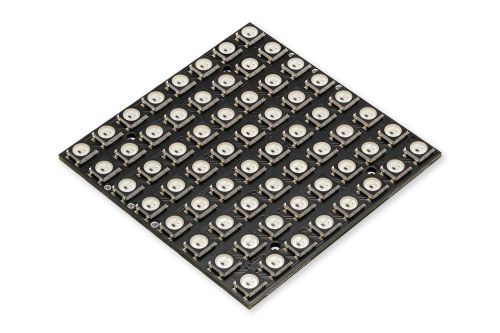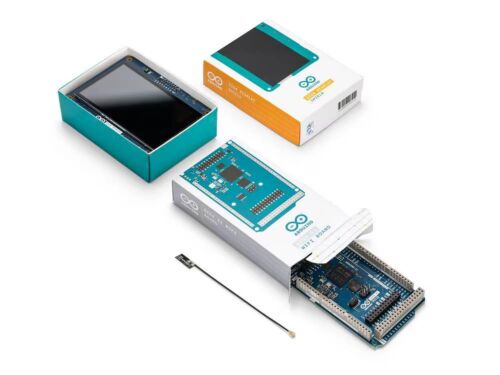Little bits is one of the most intuitive and fun STEM learning tools available. It transforms electronics into an engaging, modular approach that students, teachers, and parents will all love!
Kits
Unleash creativity and innovation with littleBits Kits, perfect for STEM education, DIY projects, and hands-on learning in electronics, coding, and robotics.
- littleBits Makerspace Invention WallSKU: CE09707 Brand: LittleBitsSphero's educational STEM robots and STEAM kits introduces kids 5+ to coding concepts, programming, and circuitry through play-based learning. Shop Sphero!...
- littleBits Code KitSKU: LBH688 Brand: LittleBitsThe secret to learning? Make. It. Fun. So this kit's all about learning to build & code through games. With games, students embrace failure, make their own rules, think critically, and collaborate.
Power Modules
Power your littleBits creations with reliable and versatile power modules, from USB and battery options to Power Over Ethernet solutions.
- littleBits USB Power (P3)SKU: LBH817 Brand: LittleBitsThe USB power may be the smallest in the series, but it's big enough to send juice to all your creations. Connect a USB cable (included) to your computer or phone charger to start the power flowing. Try it with an LED to make the simplest littleBits circuit. If you're looking for a permanent installation, the USB power adapterenables you to plug your USB power directly into the wall.
- littleBits Power (P4)SKU: LBH055 Brand: LittleBitsThis power module lets you use a 9 volt battery to supply electricity to your littleBits. Snap in the battery + cable (not included) and flip the switch to turn it on. To make the simplest littleBits circuit, connect the power Bit to an LED bit and start shining!$15.17 AUD, inc GSTAs low as $14.11 AUD, inc GST
Out of Stock
Sign up to get notified when it's available to order.
- littleBits 9V Battery + CableSKU: LBH840 Brand: LittleBitsThis package contains a 9v alkaline battery and a cable to connect it to the power Bit. Connect it up and then flip the switch to power all of your creations!
Input Modules
Enhance your littleBits projects with a variety of input modules, from sensors to actuators, making interaction and control a breeze.
- littleBits Micro SequencerSKU: LBH839 Brand: LittleBitsThe micro sequencer sends out voltages based on the position of each of the four “step” knobs. Connect it to an oscillator and it will step through the "sequence" consecutively to make a melody (The LEDs tell you which step is active). Turn a knob all the way counter-clockwise to make the step silent. Use it in "speed" mode to set the speed using the dial, or flip the switch to “step” mode to use an input module like a pulse or button for control. In addition to its main output, it also has a trigger output, which you can send to any of your other Bits modules.$52.48 AUD, inc GSTAs low as $48.81 AUD, inc GST
Out of Stock
Sign up to get notified when it's available to order.
- littleBits DelaySKU: LBH088 Brand: LittleBitsThe littleBits delay module takes incoming audio and repeats it, like an echo. It has two knobs: "time", which sets the delay length between a sound and its repetition, and "feedback", which controls how many times the sound repeats. Delays can be long and spacey, like shouting into the Grand Canyon, or loud and crazy. This Bits module will play forever if you turn up the Feedback knob all the way. [You can also shift the pitch of a sound by turning the "time" control while a sound is repeating.]
- littleBits MixSKU: LBH089 Brand: LittleBitsThe littleBits mix module allows you to combine two inputs and send them to a single output. It also has a volume control for each of its inputs -- that's where the 'mixing' comes in. Use it to play two oscillators on a single speaker!
- littleBits RandomSKU: LBH087 Brand: LittleBitsThe littleBits random module has two modes: "noise" and "random voltage". In "noise" mode, it outputs white noise, like a television set not tuned to any channel. In "random voltage" mode, it outputs random voltage signals that can control oscillators and make them play random pitches. Use the "trigger out" connector and "speed" dial of the micro sequencer to set the timing of the random output pulses and use an input Bits module like a dimmer to control the range of your random outputs.
- littleBits KeyboardSKU: LBH085 Brand: LittleBitsThe keyboard lets you play melodies- it features 13 switches that make up an entire octave of notes. It has two modes: "press" (which only produces output when you press a switch) and "hold" (which will hold the last note you played). It also features an octave control which changes the playable range. In addition to its main output, which is great for controlling littleBits oscillators, it also has a "trigger out", which you can send to the "trigger in" of envelope or other littleBits modules.
- littleBits Toggle SwitchSKU: LBH801 Brand: LittleBitsThe toggle switch Bit is sturdy on/off switch that you can use to activate your creations with a nice, solid click. Try using it after a USB power Bit as an on/off switch for your whole creation.
- littleBits Light SensorSKU: LBH082 Brand: LittleBitsThe light sensor Bit can turn your circuit on and off by detecting the brightness or darkness of the environment they are in. control your circuit's with light! The amount of light shining on the sensor will change how your circuit behaves. It's a great way to activate your circuit, and is perfect for alarms!
- littleBits Motion TriggerSKU: LBH809 Brand: LittleBitsThe motion trigger is similar to the sensor on an automatic door: when someone is moving nearby, it sends an ON signal to the following Bits. It's very sensitive, so don't breathe unless you want to be detected! Try it with some LEDs to create a security light!
- littleBits Pressure SensorSKU: LBH060 Brand: LittleBitsThe pressure sensor is a touch-activated module; give its pad a little squeeze to activate it. The more pressure you apply, the more signal it sends out. Put it in front of a vibration motor to control how much it shakes!
- littleBits Roller SwitchSKU: LBH810 Brand: LittleBitsThe roller switch is a handy Bit -- it has a little lever with a wheel, and activates when something moves past it. You can also flip the mode switch to make it turn off when the lever is pushed in. Try that mode with an LED to make a fridge light.
- littleBits Slide SwitchSKU: LBH800 Brand: LittleBitsThe slide switch is a small and convenient way to turn your creations on and off. It uses a sturdy plastic lever to switch back and forth. Try it with any of your favorite Bits, like the DC motor or bright LED!Special Price $21.19 AUD, inc GSTRegular Price $24.93 AUD, inc GSTDelivered by Dec 26th
- littleBits Sound TriggerSKU: LBH811 Brand: LittleBitsThe sound trigger listens to the noise level in your room, and sends an ON signal when it gets over a certain level. You can make that threshold louder or softer using the included screwdriver. We like to use it with an LED to light up your room when you snap your fingers.
- littleBits Temperature SensorSKU: LBH842 Brand: LittleBitsThe temperatures sensor responds to the temperature surrounding its probe. The higher the temperature it senses, the more signal it sends out.
- littleBits SequencerSKU: LBH804 Brand: LittleBitsThe sequencer allows you to connect up to eight outputs and control them in sequential patterns. Sequences that would take as long as 4 days to program without littleBits will only take you seconds!
Output Modules
Enhance your littleBits projects with versatile output modules, perfect for adding lights, sounds, and movements to your creations.
- littleBits BuzzerSKU: LBH815 Brand: LittleBitsThe buzzer Bit is just what it sounds like: it makes a noise that you just can't ignore. It buzzes whenever it gets an ON signal. Try using it to make your own doorbell or alarm!
- littleBits Servo - Cross AxleSKU: LBH072 Brand: LittleBitsThe servo is a controllable motor that can swing back and forth, or be turned to a specific position. Try attaching a flag to the servo to make it wave back and forth!
- littleBits BargraphSKU: LBH071 Brand: LittleBitsThe bargraph is one of littleBits favorite Bits: it has five LEDs in different colors that light up to show you how much signal the module is receiving. Try it with a pressure sensor to make your own strength-o-meter.
- littleBits FanSKU: LBH831 Brand: LittleBitsThe fan Bit is just what you'd think: a small electric fan tethered to a littleBits module. It's great for those hot summer nights. Use littleBits little fan to create fluttering movement in your creations or just to keep yourself cool.
- littleBits Long LedSKU: LBH075 Brand: LittleBitsThe long LED (or "Light-Emitting Diode") Bit is another lighting option. We call it the "long" LED because the light is tethered to the board by a cable. This lets you put the light in some interesting places: one of littleBits favorite tricks is to place the LED in the middle of a foam ball to make it glow!
- littleBits NumberSKU: LBH080 Brand: LittleBitsThe number module displays information about the signal it’s receiving from your other modules. It features a two-digit, seven-segment LED display.
- littleBits Servo - Hub MountSKU: LBH027 Brand: LittleBitsThe servo Bit is something that we're really excited about – a controllable motor that can swing back and forth! It has two modes: in “Turn” mode, the input from other littleBits determines the position of the arm – try using a dimmer to set the angle you want. In “Swing” mode, the servo will move back and forth on its own – the input controls how fast it goes. Attach a flag to the arm to make a signaling machine!
- littleBits DC Motor Tethered - D ShaftSKU: LBH650 Brand: LittleBitsThe DC (or "direct current") motor rotates a small shaft you can attach anything to. Try attaching a wheel! Use it to spin, turn, twist, and roll.
- littleBits Vibration MotorSKU: LBH065 Brand: LittleBitsThe vibration motor is very similar to the device that makes your cellphone shake when you get a text. With this module, you can make anything vibrate and buzz! This module also includes the vibeSnap-- an accessory that helps you attach stuff - like paper, tin foil, or a pipecleaner - to the motor.
- littleBits RGB LedSKU: LBH074 Brand: LittleBitsThe RGB LED (or "Red-Green-Blue Light-Emitting Diode") Bit is a special light whose color you can adjust. Use the included screwdriver to adjust each of the color channels to get almost any color. Use the RGB LED when you want to match the light to the color of your creation!
Wire Modules
Connect and extend your littleBits creations with wire modules, perfect for bridging gaps and adding flexibility to your electronic projects.
- littleBits SplitSKU: LBH094 Brand: LittleBitsThe littleBits split module sends a single input to two wired outputs. It's great for connecting one output to two inputs, like using a keyboard to control two oscillators. But keep in mind that it can be used just like a wire module if you ignore one of its outputs.
- littleBits NANDSKU: LBH826 Brand: LittleBitsThe NAND module is a logic gate with two inputs. Think of it as “not and.” The NAND module will always send an on signal unless both input one and input two are receiving an on signal. It’s the exact opposite of the AND module.
- littleBits NORSKU: LBH825 Brand: LittleBitsThe NOR module is a logic gate with two inputs. As its name suggests, it sends an on signal only when neither input is receiving an on signal. In other words, it’s the exact opposite of the OR module. The NOR module is good for projects in which you want the output to be on unless one or both of its inputs are triggered.
- littleBits ArduinoSKU: LBH061 Brand: LittleBitsYou can now easily incorporate programming into your littleBits circuits! It’s everything you know and love about Arduino without the breadboarding, soldering or wiring. Simply plug into your computer, snap together needed modules, and program away! You focus on the code, we'll cover the electronics.Special Price $76.97 AUD, inc GSTRegular Price $139.95 AUD, inc GSTDelivered by Dec 26th
- littleBits XORSKU: LBH827 Brand: LittleBitsThe XOR module is a logic gate with two inputs. Think of it as “exclusive or,” meaning that it sends an on signal when it’s receiving an on signal exclusively from one input or the other, but not both.
- littleBits Double AndSKU: LBH821 Brand: LittleBitsThe AND Bit is a logic gate with two inputs. Just like its name implies, it sends an ON signal from its output only when input one AND input two are both receiving an ON signal.
- littleBits Wireless TransmitterSKU: LBH833 Brand: LittleBitsYou will need a wireless receiver and a transmitter to use littleBits wirelessly. You can purchase additional receivers and transmitters, but if you are just getting started with littleBits wireless modules, we suggest purchasing the Wireless Boost It.
- littleBits Wireless ReceiverSKU: LBH832 Brand: LittleBitsYou will need a wireless receiver and a transmitter to use littleBits wirelessly. You can purchase additional receivers and transmitters, but if you are just getting started with littleBits wireless modules, we suggest purchasing the Wireless Boost It.
- littleBits InverterSKU: LBH824 Brand: LittleBitsThe inverter is a very contrary logic Bit. It sends out the opposite of whatever it receives: send it an ON signal, and the inverter changes it to an OFF signal, or vice versa. Try putting it between two lights after a button: clicking will make the LEDs blink back and forth, like the lights on top of a police car!
- littleBits LatchSKU: LBH823 Brand: LittleBitsUse the latch to turn any momentary input, like a button or a trigger module, into an ON/OFF switch, like a toggle! If you place a button in front of the latch, pressing the button once will turn it ON, and pressing it again will turn it OFF again. Or for even more fun, place a sound trigger in front of the latch, and a light after it...then, just snap your fingers!
- littleBits BranchSKU: LBH819 Brand: LittleBitsThe Branch Bit gives you more options for connecting your Bits: it lets you connect the output of a single Bit to as many as three others, oriented in different directions. Use it when you want to trigger light, sound and motion at the same time.
- littleBits Double ORSKU: LBH820 Brand: LittleBitsThe OR Bit is a logic gate with two inputs. Just like its name, if input one OR input two is receiving an ON signal, then it sends an ON signal from its output.
- littleBits ForkSKU: LBH822 Brand: LittleBitsThe fork Bit gives you more options for connecting your Bits: it lets you connect the output of a single Bit to as many as three others. The additional Bits will be right next to each other. Use it when you want to trigger light, sound, and motion at the same time.
- littleBits CodebitSKU: CE05998 Brand: LittleBitsThe codeBit levels up your littleBits circuits by allowing you to program how your Bits work.
Accessories
Enhance your littleBits projects with a wide range of accessories, from sensors and actuators to connectors and mounts, perfect for expanding your creative possibilities.
- littleBits 9V Battery + CableSKU: LBH840 Brand: LittleBitsThis package contains a 9v alkaline battery and a cable to connect it to the power Bit. Connect it up and then flip the switch to power all of your creations!
- littleBits Brick AdapterSKU: LBH843 Brand: LittleBitsThe Brick Adapter enables you to easily snap littleBits modules to LEGO® bricks. Each pack comes with brick adapter studs and sockets.Special Price $20.26 AUD, inc GSTRegular Price $23.84 AUD, inc GSTDelivered by Dec 26th
- littleBits DC Motor Tethered - D ShaftSKU: LBH650 Brand: LittleBitsThe DC (or "direct current") motor rotates a small shaft you can attach anything to. Try attaching a wheel! Use it to spin, turn, twist, and roll.
- littleBits Mounting BoardsSKU: LBH051 Brand: LittleBitsMounting boards come 2 to a pack and allow you to keep your circuit intact and move it around with ease! Simply snap together your littleBits circuit and press the feet of your modules into the holes of the mounting board.
Featured Products
View AllMakers love reviews as much as you do, please follow this link to review the products you have purchased.



















































